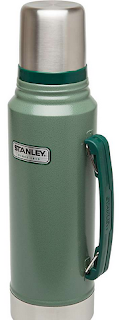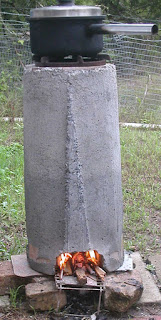Stanley Classic 1.1 QT Vacuum Bottle
I use a pair of these thermos bottles to keep a supply of hot water next to my coffee making apparatus. (A quart jar and a paper filter.)
When using my outdoor charcoal making stove as described in the previous blog, I always boil water for these bottles. Since the interior flask is stainless steel, a trick is to pour boiling water into the bottle, and then put the slightly cooled water back into the pot and wait for it to reach the boiling point again. (This pre-heats the stainless steel.) After filling the bottle, install the cap, and pull a heavy wool sock over the entire bottle to improve the insulation quality. Sometimes, I wrap both bottles with a piece of wool fabric from an old Pendleton wool shirt ($145 new), and the water stays hot for a long time.
The Stanley Thermos was invented in 1913. The patent on this bottle from 1913 shows the insulation as charcoal: "If desired, a finely divided substance may be used which will not only not give off gas to the vacuous space but will have an appetite for gas or the power of absorbing gas under the conditions of use. A suitable material for this purpose is finely divided carbon which has been highly heated to remove occluded gases and also heated in the vacuous space at the time of exhaustion to a temperature higher than the temperature at which the receptacle is to be generally used. The carbon so treated will thereafter absorb any small amounts of gas given oft' to the vacuous space by or from the metallic shells and thus aid in keeping up the exhaustion necessary for proper insulation. The carbon will so act even when hot materials are placed in the receptacle, since it is necessary to heat the carbon nearly to the temperature at which it was heated at the in order to produce the same degree of heat."
I have purchased two of these thermos bottles at garage sales, each for a couple of bucks. These bottles have a lifetime guarantee, and after filling the garage sale bottles with boiling water, and measuring the temperature ten hours later, a defective bottle can be reported to Stanley, and they will send out a new bottle. They request that you destroy the defective bottle. This is how I discovered that the vacuum space between the two steel parts contains charcoal.
To save energy, our electric water heaters are all on manual switches, and are left off unless hot water is needed for some task. The hot water in these two bottles is available when the electric heaters are turned off.
How much electrical energy equivalent is stored in the two bottles? To boil one gallon of water starting 70°F in 1 hour you will need 8.3 x (212-70) = 1,178.6 BTUs. (A BTU (British Thermal Unit) describes the amount of energy to raise 1 lb of water 1 degree Fahrenheit in one hour. Water equals 8.3 lbs per gallon. To boil one gallon of water starting 70°F in 1 hour you will need 8.3 x (212-70) = 1,178.6 BTUs.)1 btu per hour (btu/h) = 0.29 watts (W) is 342 watts for one gallon of water. 2 quarts of water is half of that, so 171 watts is stored in the bottle. (More if the starting temperature of the water is less than 70°F.)
That is not very much, but in a electric water tank, the water cools and is re-heated over and over all day long, whether it is used or not. In the Summer, when air conditioning is almost required, this lost heat from the water heater goes into the house, and is then removed by the air conditioner, costing even more electricity.
When using my outdoor charcoal making stove as described in the previous blog, I always boil water for these bottles. Since the interior flask is stainless steel, a trick is to pour boiling water into the bottle, and then put the slightly cooled water back into the pot and wait for it to reach the boiling point again. (This pre-heats the stainless steel.) After filling the bottle, install the cap, and pull a heavy wool sock over the entire bottle to improve the insulation quality. Sometimes, I wrap both bottles with a piece of wool fabric from an old Pendleton wool shirt ($145 new), and the water stays hot for a long time.
The Stanley Thermos was invented in 1913. The patent on this bottle from 1913 shows the insulation as charcoal: "If desired, a finely divided substance may be used which will not only not give off gas to the vacuous space but will have an appetite for gas or the power of absorbing gas under the conditions of use. A suitable material for this purpose is finely divided carbon which has been highly heated to remove occluded gases and also heated in the vacuous space at the time of exhaustion to a temperature higher than the temperature at which the receptacle is to be generally used. The carbon so treated will thereafter absorb any small amounts of gas given oft' to the vacuous space by or from the metallic shells and thus aid in keeping up the exhaustion necessary for proper insulation. The carbon will so act even when hot materials are placed in the receptacle, since it is necessary to heat the carbon nearly to the temperature at which it was heated at the in order to produce the same degree of heat."
I have purchased two of these thermos bottles at garage sales, each for a couple of bucks. These bottles have a lifetime guarantee, and after filling the garage sale bottles with boiling water, and measuring the temperature ten hours later, a defective bottle can be reported to Stanley, and they will send out a new bottle. They request that you destroy the defective bottle. This is how I discovered that the vacuum space between the two steel parts contains charcoal.
To save energy, our electric water heaters are all on manual switches, and are left off unless hot water is needed for some task. The hot water in these two bottles is available when the electric heaters are turned off.
How much electrical energy equivalent is stored in the two bottles? To boil one gallon of water starting 70°F in 1 hour you will need 8.3 x (212-70) = 1,178.6 BTUs. (A BTU (British Thermal Unit) describes the amount of energy to raise 1 lb of water 1 degree Fahrenheit in one hour. Water equals 8.3 lbs per gallon. To boil one gallon of water starting 70°F in 1 hour you will need 8.3 x (212-70) = 1,178.6 BTUs.)1 btu per hour (btu/h) = 0.29 watts (W) is 342 watts for one gallon of water. 2 quarts of water is half of that, so 171 watts is stored in the bottle. (More if the starting temperature of the water is less than 70°F.)
That is not very much, but in a electric water tank, the water cools and is re-heated over and over all day long, whether it is used or not. In the Summer, when air conditioning is almost required, this lost heat from the water heater goes into the house, and is then removed by the air conditioner, costing even more electricity.



Comments
Post a Comment